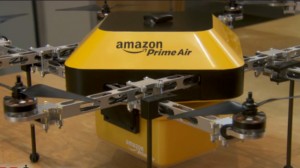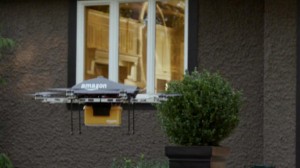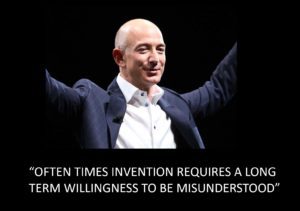 Last Wednesday, July 9, Amazon officially submitted its petition to the FAA asking for an exemption from the agency’s blanket ‘no flying drones for commercial purposes’ policy. We have yet to hear anything from the FAA, and if the status of the last such petition is any indication (seven film production companies filed a similar petition in early June and nothing has come of it yet), it will probably be a while before we do.
Last Wednesday, July 9, Amazon officially submitted its petition to the FAA asking for an exemption from the agency’s blanket ‘no flying drones for commercial purposes’ policy. We have yet to hear anything from the FAA, and if the status of the last such petition is any indication (seven film production companies filed a similar petition in early June and nothing has come of it yet), it will probably be a while before we do.
But it shouldn’t be.
In the FAA’s Integration of Civil Unmanned Aircraft Systems (UAS) in the National Airspace System (NAS) Roadmap, there are many instances in which the agency says it needs more data before it can publish any UAS regulations (i.e. Section 5.7). In addition to this, Section 6.2 of the Roadmap explicitly says “Government-industry collaboration is paramount to success and must focus on process, quality, and timely results. The FAA expects to gain experience in applying the existing airworthiness regulations during the the certification process with early UAS adopters.”
Industry collaboration? Experience via early UAS adopters? Data from field testing? Amazon is offering all of this to the FAA.
In fact, they even did one better; Amazon is going to front the cost, assume all of the risk and they have drafted their own set of rules that are more far more detailed and restrictive than they have to be.
For example, Amazon says none of its drones will exceed 55 lbs or be flown more than 400 feet above ground level. They will undergo intensive pre-flight inspection, be flown within line of sight (LOS) of one or more operators, and they will not go anywhere near manned aircraft operations. Every drone pilot will hold an FAA-issued operator license, a return home feature will be built into every system and an additional killswitch, independent of the UAS, will allow for immediate safe landing of all the drones.
And to top it all off, all flights will be conducted and monitored by Amazon personnel, on Amazon’s private property as ensured by a pre-programmed, geo-fenced area.
Amazon is asking to be treated like a hobbyist.
 The FAA’s recent Interpretation of the Special Rule for Model Aircraft, reasserted their claim that using drones for commercial purposes of any kind is prohibited.
The FAA’s recent Interpretation of the Special Rule for Model Aircraft, reasserted their claim that using drones for commercial purposes of any kind is prohibited.
Do you want to take pictures of your house for fun? Go nuts. Are you going to use those pictures to help you then sell the house without the consent of the FAA? Here is a subpeona.
The current gauntlet that is the process for obtaining FAA authorization to fly a drone commercially is a joke and has only been successfully navigated twice.
If the rate at which Amazon is testing new iterations of Prime Air continues (nine versions of the drones in five months), “it would be an unreasonable burden on both the FAA and Amazon” to force the company to acquire certification each time a new prototype needed to fly. It would stunt the program’s rapid growth.
So the house that Bezos built is asking for the FAA to treat them just like every other shmo with a Phantom. The difference is, Amazon has written their own rule book and publicly outlined how they intend to use it.
It’s Game Time
 This is it. Amazon is prepared to play the FAA’s game. They will abide by the administrations pitiful rules as long as progress is allowed to continue. All the FAA has to do is say ‘yes’ and they have the most powerful commercial drone advocate in their corner, feeding them the data they so desperately crave and a set of written -if unofficial- rules for commercial drone operations in the U.S. All at no cost.
This is it. Amazon is prepared to play the FAA’s game. They will abide by the administrations pitiful rules as long as progress is allowed to continue. All the FAA has to do is say ‘yes’ and they have the most powerful commercial drone advocate in their corner, feeding them the data they so desperately crave and a set of written -if unofficial- rules for commercial drone operations in the U.S. All at no cost.
On the flip side, the FAA could say ‘no,’ leaving Amazon no choice but find a new site to fly the drones.
(From the petition‘s introduction:)
“Because Amazon is a commercial enterprise we have been limited to conducting R&D flights indoors or in other countries. Amazon would prefer to keep the focus, jobs and investment of this important research and development initiative in the United States by conducting private research and development operations outdoors near Seattle – where our next generation R&D lab and distinguished team of engineers, scientist, and aeronautical professionals are located. In order to allow outdoor R&D testing for PrimAir in the United States, we are submitting this petition for exemption pursuant to Section 333 of the FAA Modernization and Reform Act of 2012.”
Forbes’ Greg McNeal convincingly speculates Canada would be a logical new home for Prime Air R&D should the FAA fail to grant the exemption.
Amazon has offered the FAA a free lunch and an ultimatum. Time now to see if the FAA is big enough to admit they need help.
Alan is serial entrepreneur, active angel investor, and a drone enthusiast. He co-founded DRONELIFE.com to address the emerging commercial market for drones and drone technology. Prior to DRONELIFE.com, Alan co-founded Where.com, ThinkingScreen Media, and Nurse.com. Recently, Alan has co-founded Crowditz.com, a leader in Equity Crowdfunding Data, Analytics, and Insights. Alan can be reached at alan(at)dronelife.com







[…] Amazon’s testing of retail packages and Google’s Project Wing tests of burrito delivery have garnered most of […]